Pull, grind, run, roll, wash out, burn, expose… active students are moving around printmaking studio and working at several processes simultaneously. It is different from their other art classes because there are many steps in every process. They coat something and wait for it to dry, they wait to use the press, and, while they are waiting, they have a chance to talk to the other students and it is okay! They are doing exactly what they are supposed to be doing. No wonder the process appeals to the adolescents I teach at Walnut Hill School for the Arts in Natick, MA. Talking is more than socializing; now that they know each other they help one another. They share techniques and explain things to each other. The students are excited to pull a proof and gather around to see what magical transformation occurred under the roller. Discussions happen naturally along the way.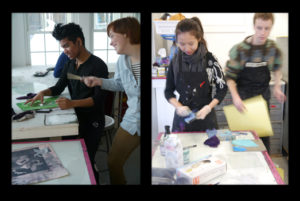 The process enhances drawings because there are many different ways to make a mark. The transformative nature is good for those who think they cannot draw. The physicality of the process helps students focus, because inscribing a plate or carving a block takes more effort than drawing with a pencil. They are confronting the unexpected and reacting to it. Each process engages the brain differently; often one works in a mirror image of the print, but in screen printing one does not reverse the image. In relief printing what is carved does not get inked; in dry point the scraping tool makes the line that collects ink.
The process enhances drawings because there are many different ways to make a mark. The transformative nature is good for those who think they cannot draw. The physicality of the process helps students focus, because inscribing a plate or carving a block takes more effort than drawing with a pencil. They are confronting the unexpected and reacting to it. Each process engages the brain differently; often one works in a mirror image of the print, but in screen printing one does not reverse the image. In relief printing what is carved does not get inked; in dry point the scraping tool makes the line that collects ink.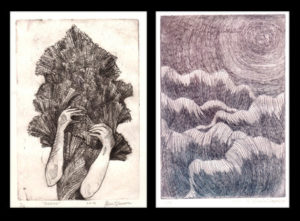 Many non-toxic colored inks are available now, so I use printmaking to teach color theory. We make monoprints in black ink and then print a transparent color layer on top. The students use limited palettes of a primary and a darker color to create two-block chiaroscuro linocuts. I tell them to “carve away to reveal the light.” By using colored papers and either reduction linocut or multi-block printing, the students can experiment and find unexpected combinations. The difficulty of learning to register consecutive blocks requires a different type of concentration. By applying the colors one at a time, they see how colors are working together.
Many non-toxic colored inks are available now, so I use printmaking to teach color theory. We make monoprints in black ink and then print a transparent color layer on top. The students use limited palettes of a primary and a darker color to create two-block chiaroscuro linocuts. I tell them to “carve away to reveal the light.” By using colored papers and either reduction linocut or multi-block printing, the students can experiment and find unexpected combinations. The difficulty of learning to register consecutive blocks requires a different type of concentration. By applying the colors one at a time, they see how colors are working together.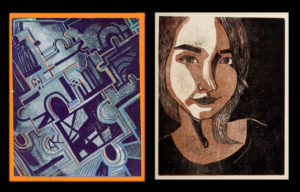 And lastly, making multiples…Making an edition of matching intaglio prints is a useful exercise. The students make state proofs to record their progress. This is helpful for a painter who is used to having all the structural decisions covered by the final layer of paint. The proofs help uncover the artist’s process. By the time the printers finish working on their copper plates, they have learned to perceive and control differences in quality. Producing multiples of a print enables the student to both save an image they like and further develop it. High school students want something they can hang on their wall and something they can save for their portfolio; that is not always possible when you are learning a new process; making multiples allows them to do both.
And lastly, making multiples…Making an edition of matching intaglio prints is a useful exercise. The students make state proofs to record their progress. This is helpful for a painter who is used to having all the structural decisions covered by the final layer of paint. The proofs help uncover the artist’s process. By the time the printers finish working on their copper plates, they have learned to perceive and control differences in quality. Producing multiples of a print enables the student to both save an image they like and further develop it. High school students want something they can hang on their wall and something they can save for their portfolio; that is not always possible when you are learning a new process; making multiples allows them to do both.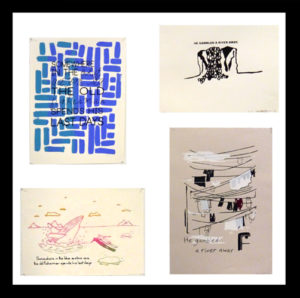 With extra copies, you are free to send some of them out into the world. We worked with the Creative Writing students and the Music Composition students within the school. The printers responded to the sounds and words to design their screen prints. They also worked with students from farther away, The Latin School of Chicago in Illinois (linocuts), and The Technical College of Reykjavik in Iceland (stencil monoprints). Instead of editions, they created a series of related images. These were printed in stages as separate backgrounds and foregrounds. They mailed some prints and kept copies for themselves. Everyone ended up with several prints.
With extra copies, you are free to send some of them out into the world. We worked with the Creative Writing students and the Music Composition students within the school. The printers responded to the sounds and words to design their screen prints. They also worked with students from farther away, The Latin School of Chicago in Illinois (linocuts), and The Technical College of Reykjavik in Iceland (stencil monoprints). Instead of editions, they created a series of related images. These were printed in stages as separate backgrounds and foregrounds. They mailed some prints and kept copies for themselves. Everyone ended up with several prints.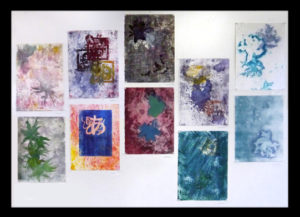 Each printmaking process offers the possibility to make expressive marks, the potential for layering images and making multiples for an edition or a series. The student is learning more than technique or how to make copies.
Each printmaking process offers the possibility to make expressive marks, the potential for layering images and making multiples for an edition or a series. The student is learning more than technique or how to make copies.
Stephanie Mahan Stigliano, copyright 2016
